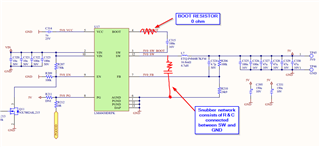Other Parts Discussed in Thread: LM43603
Dear *,
We are using LM60430D.
Vin= 12V to 24V
Vout= 5V
Iout_max= 3A
Please see the attached schematic if it looks good?
We also tried to add EMI filter in WEBENCH Power designer to our design https://webench.ti.com/power-designer/switching-regulator/customize/468
But we don't know how to select Line impedance in the EMI filter design tool ?
We want the CISPR25 CLASS5
Difference our schematic vs WBENCH schematic:
-we have 2x 10uf on input while WB has 1x10uf ( can modify the capacitance quantity in WB)
-we have 4x 47uf and 2x100nf on output while WB has 2x47uf and 1x100nf ( can modify the capacitance quantity in WB)
- we have 2x150uf 10V tantalum on output
- we have 4x100uf 35V Aluminum Electrolytic on input ( can reduce to 2x 100uF)
Please can you help to design input EMI filter with the WB tool?
Also we want to use the same 4.7uH ( ETQ-P4M4R7KFM) inductor for the filter if possible? or the 470nH CIGW252010GLR47MNE.
Best Regards,
David.





